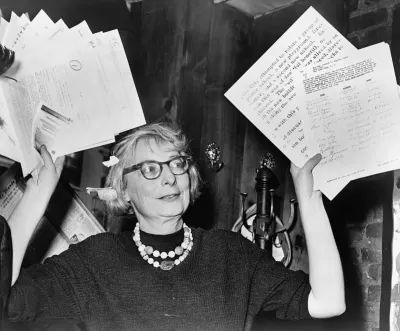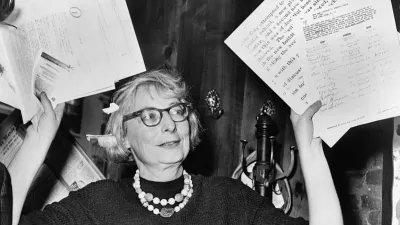Sam Hall Kaplan reviews "Eyes on Street: The Life of Jane Jacobs" and offers insight gained from personal experience with the "Saint of City Planning."

This past year was the 100th birthday of Jane Jacobs, whom many consider the Saint of City Planning. Topping off a year of accolades for Jane's 100th birthday was a new book extolling her life, prompting some reflections from me as a friend of Jane's in a distant past.
First, briefly, the book, titled Eyes on the Street: The Life of Jane Jacobs, by Robert Kanigel. It is a sweeping biography, comprehensive and complimentary, and so I comment on public radio and select websites.
Traced is Jacob's liberal leanings from her youth in Scranton, Pennsylvania, to New York City, as a struggling journalist, settling in the then rough hewn neighborhood of the West Village, and after success as an author and activist, moving on to an evolving urban Toronto.
Her's was a life championing the social and economic life of neighborhoods, with an appealing practical street smarts. This is captured by Kanigel in a direct narrative. No doubt Jane, as a plain-spoken, self-taught historian, would have approved. A passionate thinker, she was not a passionate writer.
Portrayed is the Jane I knew nearly 60 years ago when she lived in the West Village and had just written the classic The Death and the Life of Great American Cities to resounding praise.
The Village had been my stomping grounds, when in high school hanging out in Washington Square Park, and during my college summers, where I worked nights as a railroad inspector on the nearby waterfront and what is now the High Line.
A few years later I was writing about the park, and planning, forThe New York Times, and not coincidentally living in an affordable, affable East Harlem.
Jane had written disparagingly about East Harlem and the projects where I lived; how they had replaced vibrant streets of small businesses and a social network, and, yes, let me add, a rat's nest of tenements.
But to Jane's credit, she nonetheless supported my efforts and others to convert some of the projects to a moderate income cooperative, and generate a sense of community, and cheered my publishing a local newspaper, and serving on the local planning board.
We became friends, and among other things shared our disdain for city planners and their clodhopping through communities.
So much for her planning sainthood. For her, planners then were bureaucrats first and foremost protecting their jobs, and therefore at the beck and call of politicians who held sway over their budgets.
This in turn tends to leaves many of them sensitive to the entreaties of people of property with political influence. As for whom their land use decisions might affect, the neighborhoods were secondary and activists marginalized.
This was particularly true of the bad old days of the premier bureaucrat Bob Moses rending neighborhoods in New York with freeways and super block buildings, and giving ink for Jane's pen and spurring reforms.
She and the West Village prevailed, at least for a few decades, until it was discovered by yuppies and tourists, and then by the big bucks crowd, it being a short limo ride away from Wall Street. It is now among the most expensive zip codes in an expensive New York.
Gone are the eyes on the street Jane rhapsodized over in her sidewalk ballad of a caring community. Now are doorman, nannies, and concierges catering to a feckless new leisure class.
Good bye to a homey West Village, and a neighborly New York.
Still the physical features Jane so praised, the wide sidewalks, the mixed use, the human scale, and the cityscaping endures, in the West Village, in select neighborhoods everywhere, and in the tool kit of sensitized planners.
Thanks to Jane Jacobs, cities today are being made livable. She would like that. But not for the residents she knew, but rather to a new leisure class. She would not like that.
I'm Sam Hall Kaplan, and this is the city observed, on public radio 97.5 KBU, radiomalibu.net, and websites everywhere.
And yes my friends and followers, Malibu is a long ways off from East Harlem and the West Village.

Trump Administration Could Effectively End Housing Voucher Program
Federal officials are eyeing major cuts to the Section 8 program that helps millions of low-income households pay rent.

Planetizen Federal Action Tracker
A weekly monitor of how Trump’s orders and actions are impacting planners and planning in America.

Ken Jennings Launches Transit Web Series
The Jeopardy champ wants you to ride public transit.

California Invests Additional $5M in Electric School Buses
The state wants to electrify all of its school bus fleets by 2035.

Austin Launches $2M Homelessness Prevention Fund
A new grant program from the city’s Homeless Strategy Office will fund rental assistance and supportive services.

Alabama School Forestry Initiative Brings Trees to Schoolyards
Trees can improve physical and mental health for students and commnity members.
Urban Design for Planners 1: Software Tools
This six-course series explores essential urban design concepts using open source software and equips planners with the tools they need to participate fully in the urban design process.
Planning for Universal Design
Learn the tools for implementing Universal Design in planning regulations.
Ada County Highway District
Clanton & Associates, Inc.
Jessamine County Fiscal Court
Institute for Housing and Urban Development Studies (IHS)
City of Grandview
Harvard GSD Executive Education
Toledo-Lucas County Plan Commissions
Salt Lake City
NYU Wagner Graduate School of Public Service




























